Review: 500's are just fun
Moto Guzzi 250 TS, 350 NTX, 650 NTX, 750 NTX, 750 SP, 750 T, 750 XPA, Breva 750, Nevada 350, Nevada 750, STR V750 IE, Targa 750, V35, V35 Florida, V35 II, V35 Imola, V50, V50 II, V50 III, V50 Monza, V65, V65 Florida, V65 SP, V7 Café Classic, V7 Classic, V7 II Racer, V7 II Special, V7 II Stone, V7 Racer, V7 Special, V7 Stone, V75, and V85 models
Updated:
I have been meaning to write a comparison of my 3 Italian middleweights for some time now. It often comes up in discussion forums how their bike compares to the competition so with the benefit of ownership I will try and be as objective as I can.
The 3 bikes are, in order of purchase:
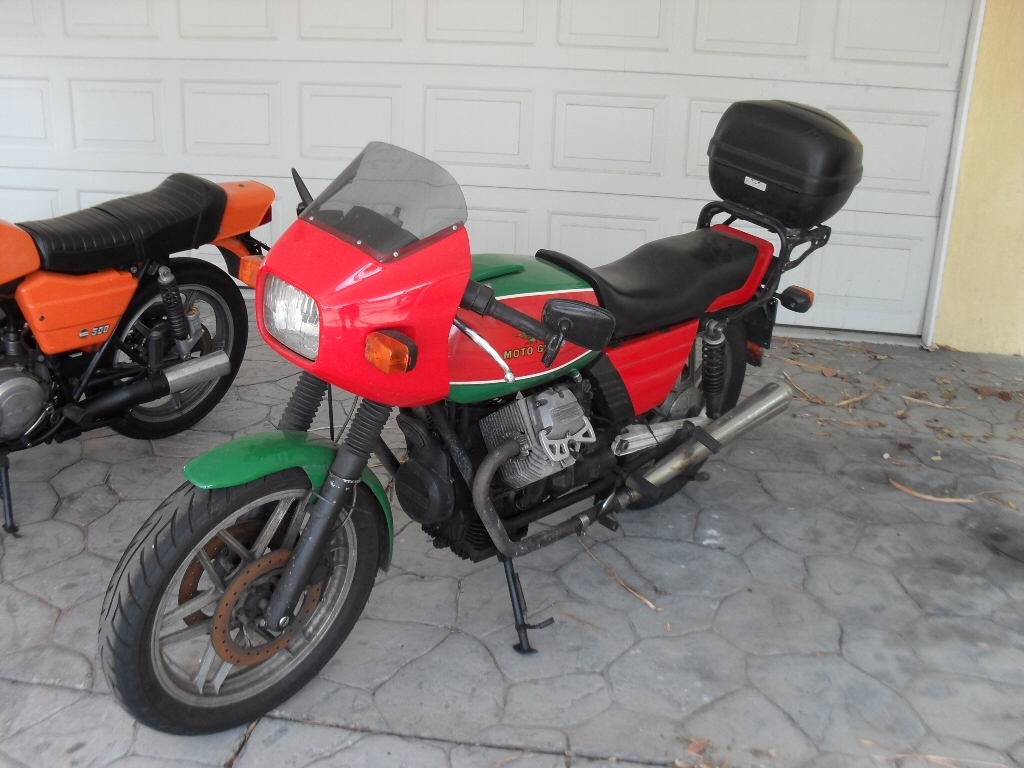
Photo courtesy of Rod Yeomans.
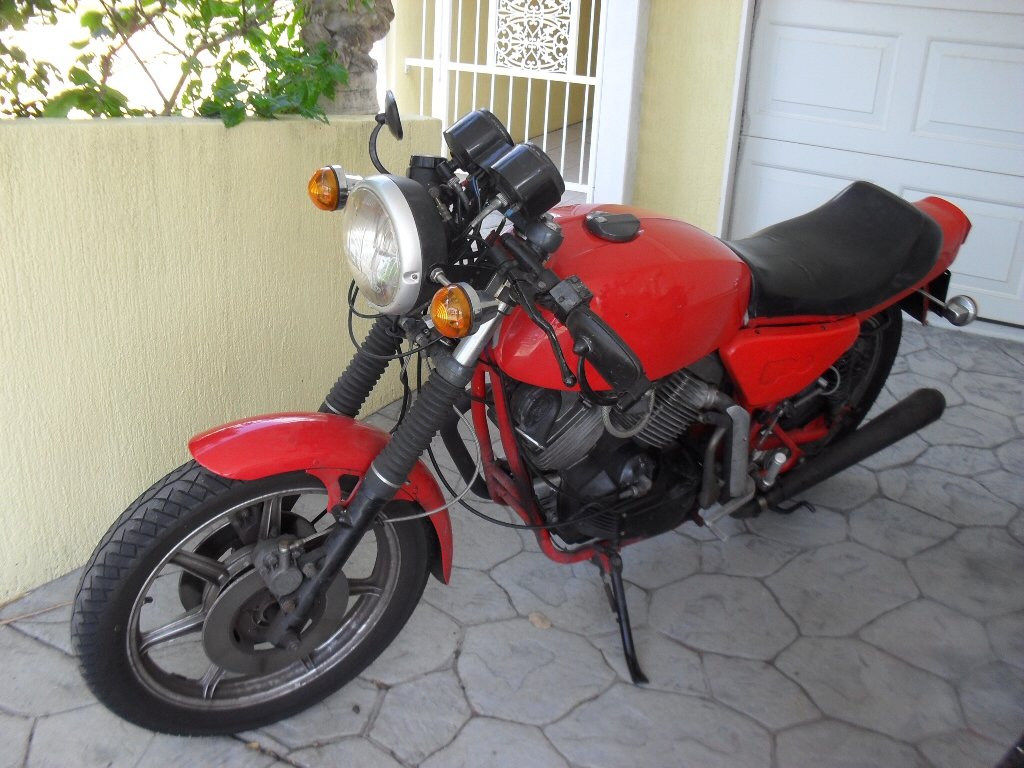
Photo courtesy of Rod Yeomans.
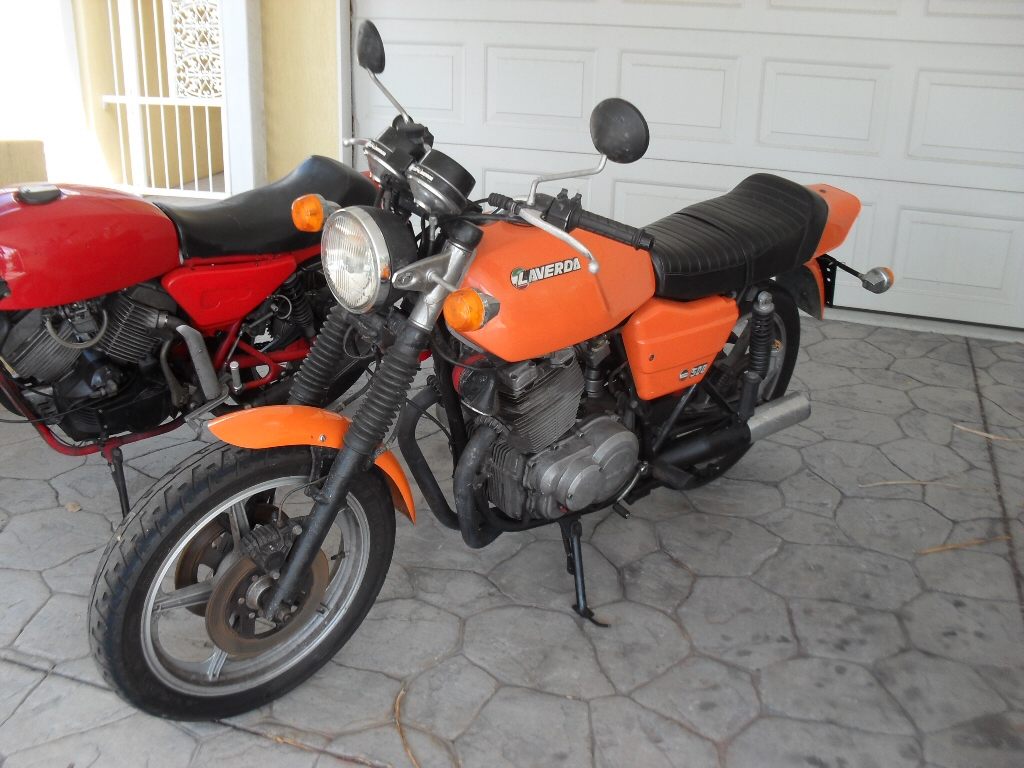
Photo courtesy of Rod Yeomans.
I recently went and inspected a Ducati Pantah 500 as I was curious to compare it to the other bikes and I thought it would be interesting to own a 4th Italian half tonner but it wasn't to be. I just couldn't justify the cost and I will add my thoughts in the relevant sections.
My Monza isn't very standard even though it looks like it is. I can only guess that it has had a major incident in its past. A 35 mm Marzocchi front end, a V65 motor and a completely non-standard colour scheme lead me to that conclusion. Yes the Monza is a 650 so it does have more power, torque and noise than the other 2 but I have ridden 500 Guzzis so I will do my best to take that into consideration.
The Morini has had a hard life too. It is on first oversize pistons and I've needed to give the top end a bit of a refresh. It also has more thread inserts in it than any other bike I have owned. Still, it holds together and I have given the body work a light touch up as it was very sad when I first got it. I know of several Morinis within a 100 km radius of me and this is the only one I know that is a runner and I simply intend to keep it that way.
The Alpino was a UK bike. It hasn't done that much as it only has 35,000 odd miles on the clock but it was suffering a bit with corrosion when it arrived. I'm pretty sure the mileage is correct as the tyres on it when it arrived were made in 1986. It is fairly standard except for the 2 into 1 exhaust that I don't like.
Engine
You would be hard pressed to find 3 air cooled twins that are more characterful. The Guzzi has a transverse 90 deg V twin, heron head, pushrod motor. The Morini has an inline 72 degree V twin, heron head, pushrod motor and the Alpino has a 180 deg parallel twin, DOHC with 4 valves per cylinder.
The Guzzi really lets you know it is there. The torque reaction, even at a standstill, throws the bike into your right leg at every twist of the throttle. To be honest, after 29 years of Guzzi ownership I really don't notice this anymore but I can still remember when I did. If you are unused to this then don't let it put you off. The shaft drive also gives feedback. As the clutch is let out the drive forces down at the back wheel and lifts the rear of the bike. Again this is a sensation that I rarely notice now but it is a reason why the Guzzi is harder to lift the front wheel under power. Not that any of the 500's are likely to rip the rubber from the rims.
It is equipped with Dellorto PHBH 28 carbs that seem well suited and the ignition is a standard type affair that is driven directly off the front of the camshaft. Mine has a Dyna S that is very low maintenance but there are other electronic options out there as are the old points and condensers.
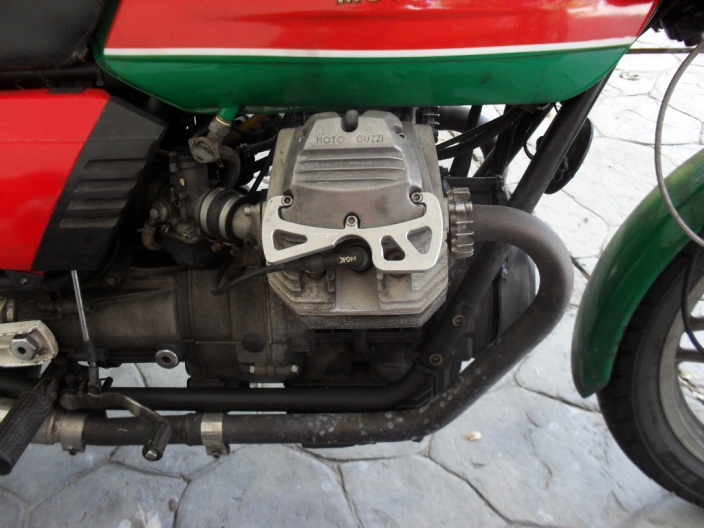
Photo courtesy of Rod Yeomans.
The Morini, the only one with a back-up kick start, is also quite visceral but in a more subtle way. All its torque reaction is on the bike's long axis. It took me a while to get used to it but the bike rewards you when you get it right. Right gear, right revs with the right amount of throttle the little thing just seems to surge forward but you do need to pay attention to keep it there.
The Heron headed engine doesn't have a direct oil feed to the top end. All valve and rocker lubrication is via oil mist carried by the breather system. It seems strange but it works. Any work under the covers does give you the option to give a bit of a squirt for oil just to ease the paranoia though. The Guzzi uses this system partially too with drip fangs under the rocker covers but it has a direct oil pressure feed to the rockers as well.
The Morini also is equipped with PHBH carbs that also seem to do a good job and are suited to the size of the engine with a choke of 26mm. The ignition is completely different with a twin winding magneto system. One to charge the battery and the other to power the ignition transducers that are AC. The bike can be started and will run without a battery but of course none of the other electrics will operate.
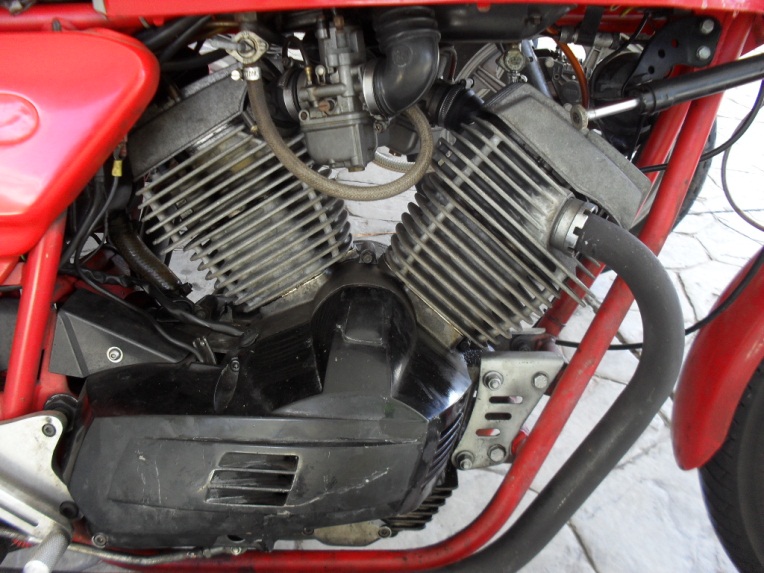
Photo courtesy of Rod Yeomans.
The Alpino is a bit of a quandary to me. It has a chain driven DOHC set up with 4 shim adjusted valves per cylinder but then it is given an 8.6:1 compression ratio whilst the other 2 are 10 or so. The Alpino is the lower tuned of the Laverda 500 range so it has the most potential for uprating whilst its heron headed stable mates are near the top of their range.
Despite this the Alpino pulls well from around 3000 RPM and is the smoothest of the 3. At first I felt the need to keep the bike at higher revs as the red line indicates but as I relaxed on it I found that as long as the throttle was metered it would forgive any poor choice of gearing. Despite advice the bike runs fine on RON 91. I have suffered no pinging or pre-ignition and I'm guessing this is due to the low compression ratio. The Morini and Monza also exhibit a very tolerant attitude to fuel despite the higher compression.
The Alpino also uses Dellortos but PHF 32 pumpers. I'm of the opinion that it is over carbed and it would probably be fine with PHBH's like the other 2. The greater air velocity in the venturi would negate the need for the pump without losing any of the responsiveness. This may reduce the top end by a small amount but the 500 is at home in tight corners. If you are only concerned with top end speed, then what are you doing on a 500? The Ducati, with even bigger carbs is even more of a curiosity to me.
The ignition is a Bosch wasted spark system that doesn't have an advance curve, just a static and full advance system that changes around the 2500 RPM mark! When warming the bike it likes to have some revs but if you allow it to drop below this in the transition period then it will just die. I see the combination of this and the large carbs to be the main hurdles for smooth running until it is hot.
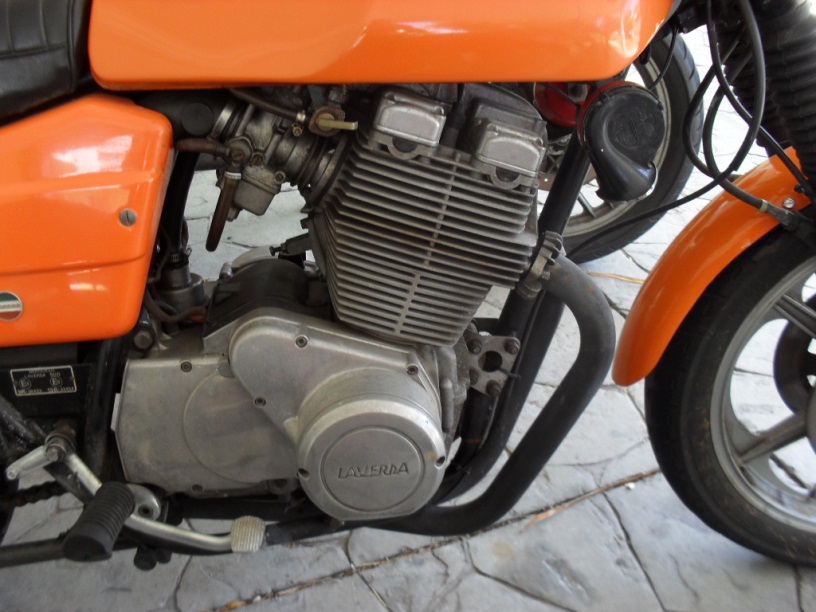
Photo courtesy of Rod Yeomans.
Gearbox
Both the Morini and Laverda have a 6 speed multi plate clutch. They are very slick and work well until you try and find neutral. Both are difficult and if time allows neutral should be searched for whilst rolling to a stop because both neutrals go into hiding once stationary.
The Monza has a 5 speed straight cut box that has an automotive style dry clutch. The clutch plate is even from a Fiat. Guzzis have a reputation for false neutrals but this is a misnomer. Big block Guzzis like the Le Mans are more renown but if they are properly shimmed with the linkages adjusted this is unjust. The small blocks, like the V50, have a much better system and even though the straight cut gears can develop a bit of a howl, at least neutral is there whenever you desire.
Handling
The bike's share similar recommended tyre profiles from 90/90/18 to 100/90/18 on the front and 100/90/18 to 110/90/18 on the rear but I've only ever run 100/90/18 on the fronts and 110/90/18 on the rear. Rear shock absorbers are similar choices too and all are around the same weight with the claimed being Monza 160kg, Morini 167kg and the Alpino 171kg.
My Monza has a non-standard 35 mm Marzocchi front end, the Morini a similar set up as is the Alpino.
Despite the single front down tube on the Alpino compared to a more engineering braced system on the Monza and Morini all of them handle well with no noticeable frame flex. The Alpino seems to crave more counter steering in the corners though. All 3 will readily respond but you can actually feel the inside bar coming back into your glove on the Alpino. I really don't want to be in a situation that any of them are at their limit as that is a long way ahead of my ability.
My main limiting factor on the Morini is the RH gear changer. I can coordinate that but my left foot refuses to be able to meter out the correct amount of pressure for the rear brake. For my own safety I have learned to just ignore its existence.
The Monza has the Guzzi patented linked braking system and I like it. I like the fact that the foot lever operates the front LH caliper with the rear at about a 70:30% ratio. I like that I can confidently apply the brake in a corner and the bike doesn't dive or straighten up, just settles a bit. Dr John Wittner's racer that won the 1985 Endurance GP championship had all 3 calipers linked so I will not be convinced it isn't a good system. If you can't ride it then don't blame the bike. I am constantly amazed by how busy my right hand is when I'm on one of the others and how the 4 limbs share the control functions on the Guzzi.
The Alpino is the only one of the 3 with standard bars. It allows the rider to sit up a bit more and have good all round vision. The Monza and Morini aren't too bad though as the reach isn't that far so the position still allows comfort and reasonable elevation in traffic.
Touring
This is where the Monza really shines. It has a 16 L fuel tank, it uses around 5 L/100 km (usually less) and so it is capable of over 300 km range. Despite a claimed 15 L tank on the Morini I can only get 12.5 L in mine so its usable range isn't that much over 200 km. The Alpino with a 14.5 L tank and around 6 L - 6.5 L/100 km is no better. In fact the Alpino is the thirstiest bike I own. I tend to blame this on both the carbs and ignition system once again.
The Monza is the ugliest of the 3, no questions but it is the exposed frame and attachment points that allow racks and gear to be carried. Both the Alpino and Morini have wrap around bodywork that inhibits their ability to bolt on gear. The Ducati Pantah was the same. Without carving into the plastic bodywork the options were very limited. I do not do back packs and bikes together.
Stands are essential to me when travelling. The Alpino and Morini have reasonable side stands for deploying from the saddle but the Monza's is a bit dicey as it is spring loaded and too short. This is easily overcome by sleeving an extra 25 mm onto the stand and altering the spring attachment. Now it is better than the others. The Pantah doesn't come with one fitted as standard. All of them have good stable centre stands for any normal conditions.
Instruments
The instruments are adequate on any of them as long as you are not the paranoid sort. The Morini and Monza share Veglia analogue gauges and the Alpino has ND's. I strongly suspect the ND's are more accurate but all work within practical limits once you are used to their exaggerations. The Tacho's are driven via cable from the engine and the speedos are all driven by cable from a rotating gear sender unit mounted on the front axle. All of them work on identical principles but none of the sender units is interchangeable.
The Monza is the only one with a full set of dash lights. It has lights for high and low beam, electrical charging, low oil pressure, neutral and even to indicate which turn signal is flashing. The Morini is more basic. Due to the Magneto ignition there is no charge circuit light, it only tells you that a turn signal is flashing, not which one and it obviously figures if you can't work out if you are in neutral or not then that is your problem. The Alpino has a light for charging, neutral, high beam and a single combined light for both turn signals.
Ownership
This is where it gets even more subjective. It all depends on what you enjoy and what you plan to use the bike for. If it is to just look at then get a Morini. A beautiful café racer straight from the manufacturer but the Alpino isn't that far behind. I don't buy classic bike magazines and I don't care that much about what other people think but if you enjoy the attention the Morini or Laverda are for you.
Maintenance on the Monza is a breeze. Access to everything is so much better than the other 2 and it has a real oil filter rather than a sieve. The only thing that is a bigger job is changing the clutch but due to the way the frame comes apart the engine and gearbox can be wheeled away from each other this is still easily done by the backyard mechanic.
The Guzzi world is so much bigger too. I don't know how many small block Guzzis were ever made but the numbers would dwarf both the Morini and Laverda combined. Ducatis are spread throughout the world too but there are only a handful of Morini and Laverda support centres.
If you are close to one then you are lucky, as I am with Red and Max for the Alpino. If not then factor that into your thinking.
I sacrifice a pair of trousers to the Morini on a regular basis. The rear exhaust exits from the rear of the head on the left hand side and despite the use of a heat guard it manages to burn a hole in my trouser leg with varying degrees of penetration. This is only a slight annoyance compared to the screw in exhaust collars. I have read horror stories of these being locked in position but mine refuse to stay in there. They are constantly unwinding themselves and I am reluctant to drill, tap or safety wire them in place.
The Alpino is the only one that uses small spark plugs. An 18 mm spanner is required. The only annoyance with it to me is the non-standard 2 into 1 exhaust. It runs directly under the oil drain requiring the exhaust to be removed for servicing and I find it much harder to tune the bike as I can't balance it by ear and feel.
Conclusion and which one is best?
There is no answer to this. Each individual will have their choice. For me it's the Monza. Just a good honest all round practical bike that is cheap to maintain but if you like standing out in a crowd then it isn't for you.
I rarely get a comment on the Monza. I rarely get away without one on the Morini and Alpino. So much so that I have removed the badges from the Morini so it can go unnoticed with the Classic Bike crowd.
All of them will make you feel like a 19 year old again on the right road and this can all be done within the legal limit. It all has to do with the sensation of speed. If you can see the horizon, if you can see a few hundred metres in front of you, then you are in the wrong place.
The Alpino has the most potential to hotrod. Montjuic specs and looks are within your grasp if you have the cash. Personally a better ignition system would do wonders and I would also consider PHF 30 carbs to help with responsiveness. Damn the top end.
The only real way to upgrade a 500 Monza is to stick a 650 or 750 motor in it.
This is easily done due to all the same attachment points and the fact the frame hasn't changed significantly since the late 70's. Mine has a 650 and it is the easiest way to upgrade any of the 3 and fuel injected 750 motors for them are still being rolled off the assembly line. The US military even had some high spec engines developed for their drones. It will be interesting to see what they like when they are finally sold off through disposals.
Morinis did have a later, uprated engine but if you aren't in one of the main Morini hubs good luck finding one at a cost effective price.
I actually like all of them for different reasons. I get on any of them and after a few minutes I think this is great, I need to ride this more often.
The only one that differs is the Monza. It can actually be easily used for more than a day ride/café racer. It is the reason I didn't buy the Pantah. I already had a Morini and Alpino for that job.
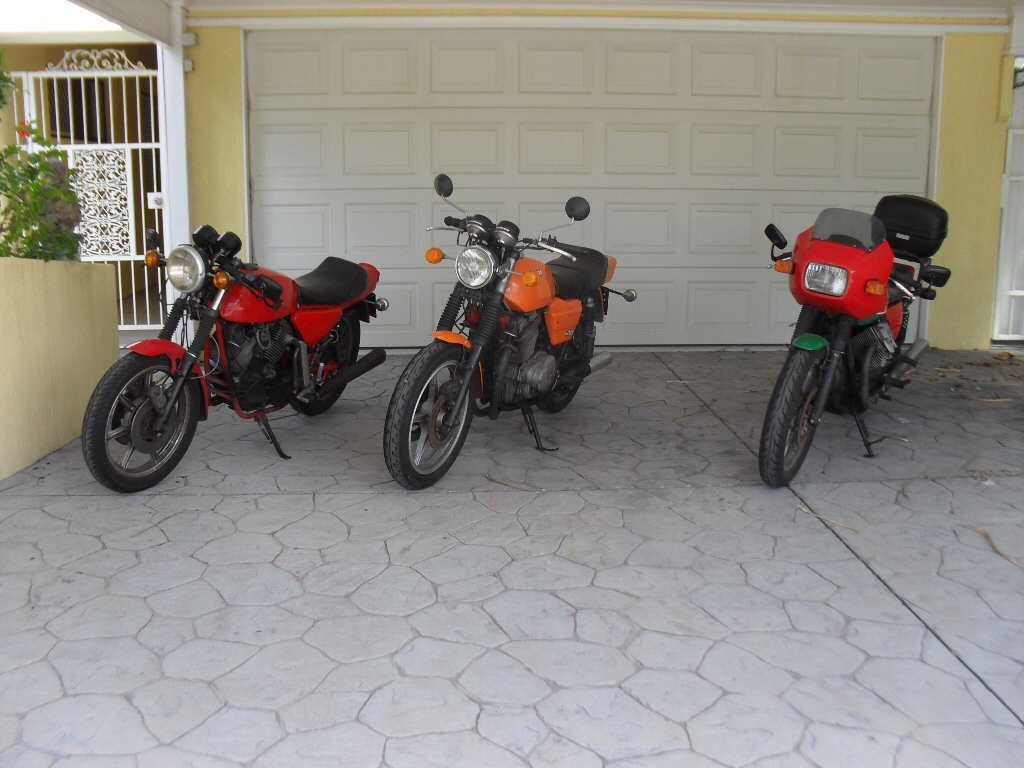
Photo courtesy of Rod Yeomans.